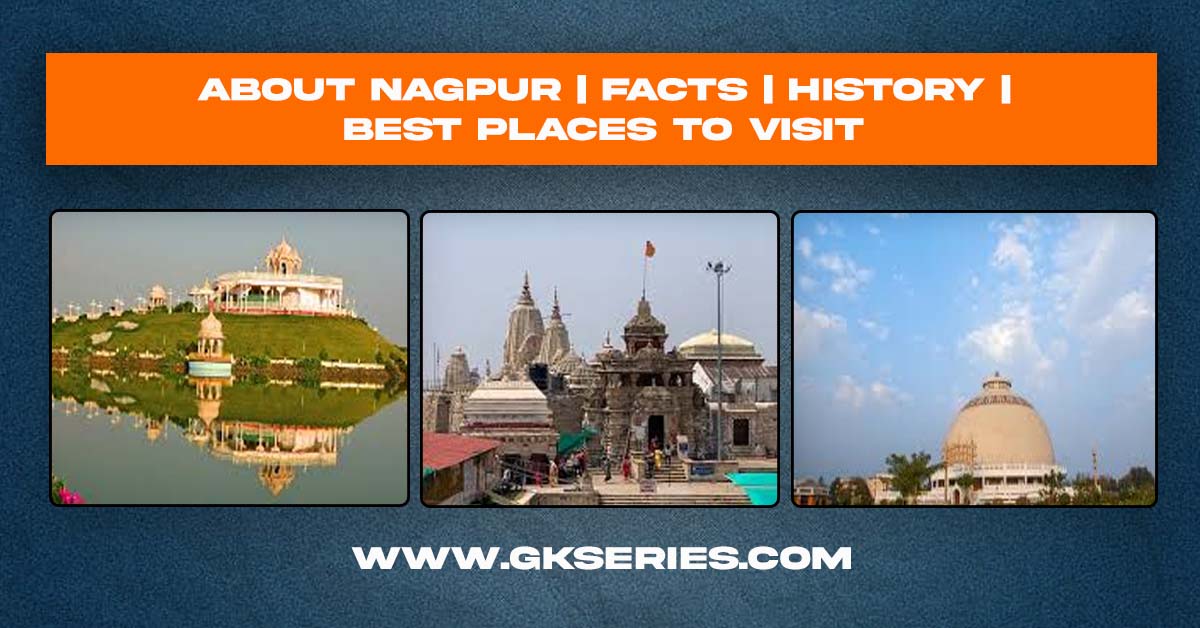
In this article, we provide comprehensive information about the geography, history, population, and top tourist destinations of Nagpur. Nagpur, famously known as the “Orange City,” is a lively and bustling metropolis located in the heart of Maharashtra. Steeped in history and cultural heritage, it beautifully blends tradition with modernity. As a key commercial and political center, Nagpur holds immense significance. Its central location has earned it the title of “India’s Heart,” marked by the iconic Zero Mile Stone, which represents the geographical center of the country.
| About: | Nagpur city is the winter capital of the state of Maharashtra, with a population of 46,53,570. In addition to being the seat of annual winter session of Maharashtra state assembly “Vidhan Sabha”, Nagpur is also a major commercial and political center of the Vidarbha region of Maharashtra. ” Nagpur is also famous throughout the country as “Orange City” for being a major trade center of oranges that are cultivated in the region. It was established about the first half of the eighteenth century by prince of the Gond tribe “Bhakt Buland”. Nagpur is the exact central city of the country with the “Zero Mile Marker” signifying the geographical centre of India. It consists of 14 Talukas and 12 Assembly Segment Constituencies. |
| History: | Nagpur is the winter capital of the state of Maharashtra, a fast growing metropolis and third largest city in Maharashtra after Mumbai and Pune. With a population of 46,53,570 (2011) Nagpur Metropolitan Area is the 13th largest urban conglomeration in India. It has also recently been ranked as the cleanest city and the second greenest city of India . In addition to being the seat of annual winter session of Maharashtra state assembly “Vidhan Sabha”, Nagpur is also a major commercial and political center of the Vidarbha region of Maharashtra, and is also famous throughout the country as “Orange City” for being a major trade center of oranges that are cultivated in the region. In addition, the city also derives political importance from being the headquarters for the RSS and an important location for the Buddhist movement. The city was founded by the Gonds but later became part of the Maratha Empire under the Bhonsles. The British East India Company took over Nagpur in the 19th century and made it the capital of the Central Provinces and Berar. After the first reorganisation of states, the city lost its capital status but according to the “Nagpur Pact” between political leaders it was made the second capital of Maharashtra. Nagpur is also called, “Tiger Capital of India ” as it connects many Tiger Reserves in India to the world. It is among the important cities for IT sector in Maharashtra after Pune. Nagpur lies precisely at the center of the country with the Zero Mile Marker indicating the geographical center of India. |
| Geography: | Nagpur is situated at the exact center of the Indian subcontinent, near the geometric center of the quadrilateral connecting India’s four major metropolitan cities: Chennai, Mumbai, New Delhi, and Kolkata. The city is home to the Zero Mile Stone, a marker used during British rule to measure distances across the Indian subcontinent. Located on the Deccan Plateau, Nagpur has an average elevation of 310.5 meters above sea level. The underlying rock strata are covered with alluvial deposits resulting from the flood plain of the Kanhan River. In some places, these give rise to granular, sandy soil. In low-lying areas, which are poorly drained, the soil is alluvial clay with poor permeability characteristics. In the eastern part of the city, crystalline metamorphic rocks such as gneiss, schist and granites are found, while in the northern part, yellowish sandstones and clays of the lower Gondwana formations are found. Nagpur city is dotted with natural and artificial lakes. The largest lake is Ambazari Lake. Other natural lakes include Gorewada Lake and Telankhedi lake. Artificial lakes such as Sonegaon and Gandhisagar were built by historical rulers. The city’s natural drainage is supported by the Nag River, Pilli Nadi, and various nallas. Known for its abundant greenery, Nagpur was ranked the cleanest and second-greenest city in India after Chandigarh in 2010. |
| Country : | India |
| State: | Maharashtra |
| District: | Nagpur |
| Region: | Vidarbha |
| Language: | Marathi |
| Population: | Nagpur Metro: 2,405,665 (2011) |
| Literacy rate: | Average literacy rate of Nagpur city is 91.92 percent of which male and female literacy was 94.44 and 89.31 percent. The sex ratio of Nagpur city is 963 per 1000 males. |
| Major Attractions to Visit: | 1. Deekshabhoomi 2. Sitabuldi Fort 3. Futala Lake 4. Ambazari Lake and Garden 5. Raman Science Centre 6. Maharaj Baug and Zoo 7. Dragon Palace Temple 8. Nagzira Wildlife Sanctuary 9. Gorewada Lake and Biodiversity Park 10. Khindsi Lake 11. Seminary Hill 12. Zero Mile Stone 13. Japanese Rose Garden 14. Markanda Mahadev Temple 15. Ramtek Fort Temple 16. Pench Tiger Reserve (near Nagpur) |





